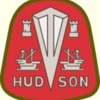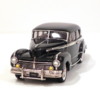American Motors History Part II Hudson.
The name "Hudson" came from Joseph L. Hudson, a Detroit department store entrepreneur and founder of Hudson's department store, who provided the necessary capital and gave permission for the company to be named after him. A total of eight Detroit businessmen formed the company on February 20, 1909, to produce an automobile which would sell for less than US$1,000.
In 1919, Hudson introduced the Essex brand line of automobiles; the line was originally for budget minded buyers, designed to compete with Ford and Chevrolet, as opposed to the more up-scale Hudson line. The Essex found great success by offering one of the first affordable sedans.
The company had a number of firsts for the auto industry; these included dual brakes, These were a mechanical backup to their hydraulic brakes. Hudson also used a smooth as silk wet clutch as opposed to a dry plate clutch. The use of dashboard oil-pressure and generator warning lights, and the first balanced crankshaft, which allowed the Hudson straight-six engine, dubbed the "Super Six" (1916), to work at a higher rotational speed while remaining smooth, developing more power for its size than lower-speed engines.
In 1932, Hudson began phasing out its Essex nameplate for the modern Terraplane brand name. The new line was launched on July 21, 1932, with a promotional christening by Amelia Earhart. For 1932 and 1933, the restyled cars were named Essex-Terraplane; from 1934 as Terraplane, until 1938 when the Terraplane was renamed the Hudson 112. An optional accessory on some 1935-1938 Hudson and Terraplane models was a steering column-mounted electric gear pre-selector and electro-mechanical automatic shifting system, known as the "Electric Hand", manufactured by the Bendix Corporation. This took the place of the floor-mounted shift lever, but required conventional clutch actions. Cars equipped with Electric Hand also carried a conventional shift lever in clips under the dash, which could be pulled out and put to use in case the Electric Hand should ever fail. Hudson was also noted for offering an optional vacuum-powered automatic clutch, starting in the early 1930s.
As ordered by the Federal government, Hudson ceased auto production from 1942 until 1945 in order to manufacture materiel during World War II, including aircraft parts and naval engines, and anti-aircraft guns. The Hudson "Invader" engine powered many of the landing craft used on the D-Day invasion of Normandy, June 6, 1944.
In 1948, the company launched their "step-down" bodies, which lasted through the 1954 model year. The term step-down referred to Hudson's placement of the passenger compartment down inside the perimeter of the frame; riders stepped down into a floor that was surrounded by the perimeter of the car's frame. The result was not only a safer car, and greater passenger comfort as well, but, through a lower center of gravity, good-handling car. In time almost all U.S. automakers would embrace it as a means of building bodies.
For the 1951 model year the 6 cylinder engine got a new block with thicker walls and other improvements to boost Horsepower by almost 18% and torque by 28.5% making Hudson a hot performer again. The GM-supplied 4 speed Hydramatic automatic transmission was now optional in Hornets and Commodore Custom 6s and 8s.
Hudson's strong, light-weight bodies, combined with its high-torque inline six-cylinder engine technology, made the company's 1951–54 Hornet an auto racing champion, dominating NASCAR in 1951, 1952, 1953, and 1954.
For 1953 Hudson Introduced the compact Hudson Jet, The sales fell well below expectations and because of its development cost the company had no money to develop a replacement for the aging step down models
In 1954 The full sized Hudson continued with the mildly restyled 1848 body. They also introduced the stunning and expensive Italian bodied Hudson Italia. It was built on the Jet chassis and they only produced 20
On May 1, 1954, Hudson merged with Nash-Kelvinator Corporation to become American Motors. The Hudson factory, located in Detroit, Michigan, was converted to military contract production at the end of the model year, and the remaining three years of Hudson production took place in Kenosha, Wisconsin.
Here are some 1/43 pre AMC Hudson models
1936 Hudson Terraplane sedan by Brooklin
1941 Hudson Commodore by Western
1948 Hudson Commodore coupe by American Excelance/NEO
1954 Hudson Hornet sedan by Brooklin
1954 Hudson Italia by Brooklin
Next week, American Motors History Part III,
Independence, Kaiser Jeep , Renault & Chrysler
CLICK HERE for last weeks Chronicle.


















